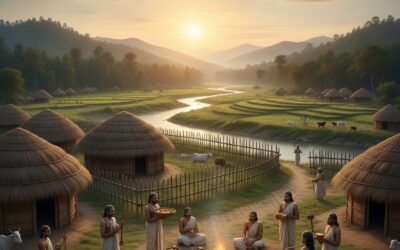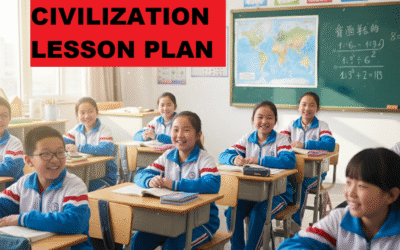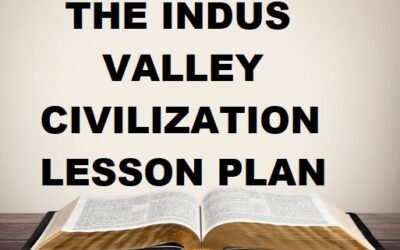Class VI History Chapter 5 Lesson Plan 2023-24
Welcome to the Class VI History Chapter 5 lesson plan, where we delve into the intriguing world of “Kings, Kingdoms, and an Early Republic.” In this chapter, we will explore the dynamic interplay between rulers and their realms, as well as the emergence of a nascent republic amidst a backdrop of powerful monarchies. By the end of this chapter (Class VI History Chapter 5), students will not only gain historical insights but also a deeper appreciation for how the past has shaped the world we live in today. This Class VI History Chapter 5 lesson plan will definitely act as a road map in your class and will cater the needs of all your students.
So, let’s embark on this historical journey of Class VI History Chapter 5 lesson plan together!
Class VI History Chapter 5 Lesson Plan 2023-24
Topic Covered:
Kings, Kingdoms, and an Early Republic
General Objective:
Firstly, to develop students’ interest in the subject.
Secondly, to understand society and its place within it.
Thirdly, developing scientific temperament among the students.
Fourthly, to develop skills of inquiry, investigation, and analysis.
Finally, to enhance students’ learning ability.
Specific Objective:
Understanding Historical Transitions:
The primary objective is to help students comprehend the transition from monarchical rule to the early stages of a republic in ancient India
Exploring the Role of Kings and Kingdoms:
Another objective is to familiarize students with the roles and functions of kings and kingdoms in ancient India. They will learn about the power structures, governance, and socio-economic dynamics that characterized these historical entities.
Analyzing the Emergence of Early Republics:
The chapter aims to educate students about the emergence of early republics in India, where collective decision-making and participation of citizens played a pivotal role. Students will analyze the factors that led to the formation of these republics and their significance in shaping Indian history.
Developing Critical Thinking and Historical Perspective:
Beyond factual knowledge, the chapter intends to foster critical thinking skills and historical perspective. Students will be encouraged to evaluate historical events and their consequences, enabling them to draw connections between the past and contemporary society.
Class VI History Chapter 5 Lesson Plan 2023-24
Checking Previous Knowledge:
At first, the teacher checks the previous knowledge of the students by asking a few questions.
- Can you name any ancient Indian kingdoms or dynasties that existed before the period covered in this chapter? What do you know about them
- What was the political and social organization like in ancient India during the time of kingdoms and republics? How did these societies function?
- Do you have any knowledge of the major historical events or developments that occurred during this period, such as notable rulers, conflicts, or advancements in governance and administration?
- Can you identify any key figures or leaders from this period and describe their roles and contributions to the development of ancient India?
These questions will help the teacher understand the students’ prior understanding and provide a foundation for the upcoming chapter on Kings, Kingdoms, and an Early Republic.
Introducing Topic:
Teacher: Good morning, class!
Today, we’re diving into an exciting chapter, “Kings, Kingdoms, and an Early Republic.” This chapter will transport us back in time to ancient India, where the land was not just a vast expanse of geography, but a tapestry woven with the stories of powerful kings, intricate kingdoms, and the emergence of early republican systems.
Student: Why are we learning about this ancient history?
Teacher: Excellent question, Would anyone like to answer his question?
Student1: Understanding our past helps us comprehend the present and future.
We’ll explore the political structures, social dynamics, and significant historical events that shaped the course of our nation.
Plus, it’s a fascinating journey through time!
Student 2: Can you give us a sneak peek of what we’ll be studying?
Teacher: Certainly,
We’ll learn about remarkable kingdoms like the Mauryas, the Guptas, and the Cholas, who left an indelible mark on Indian history.
We’ll also unravel how republics, like the ones in ancient India, operated and why they were crucial.
So, get ready to uncover the stories of ancient rulers, political intrigues, and the roots of our democratic traditions.
Student: Sounds intriguing! What can we expect to gain from this chapter?
Teacher: Great question.
By the end of this chapter, you’ll have a deeper understanding of how our civilization evolved.
The diversity of kingdoms that thrived, and the early seeds of republicanism that continue to influence our modern governance.
Moreover, you’ll get a taste of the rich cultural heritage that flourished during this period. So, let’s embark on this historical adventure together!
Statement of Topic
O.K. So, today we are going to read about “Kings, Kingdoms, and an Early Republic”
Class VI History Chapter 5 Lesson Plan 2023-24
Teaching Methodology: storytelling
The teacher explains the chapter by narrating a short story on Kings, Kingdoms, and an early Republic to draw the attention of students.
Once upon a time in ancient India, there existed a fascinating tapestry of Kings, Kingdoms, and an early Republic.
The land was ruled by mighty dynasties like the Mauryas and Guptas, whose empires stretched far and wide, showcasing remarkable governance and cultural achievements.
Amidst these grand kingdoms, there were republics, such as the Lichchhavis and Vajjis, where people participated in decision-making and governance through assemblies.
This period witnessed brilliant scholars like Kautilya, who penned the Arthashastra, guiding rulers in statecraft.
The legacy of this era, a harmonious blend of monarchy and republican values, continues to shape the very fabric of modern India’s democratic traditions
Teaching aids:
Text Book, Black Board, Youtube videos, Images, and PPT
Content/ Teaching Points:
- Introduction to Ancient India
- Kingdoms and Dynasties
- Political Structures:
- Economic and Cultural Achievements
- Emergence of Republics
- Kautilya and the Arthashastra
- Social Life and Diversity
- Religion and Philosophy
- Trade and Contacts
- Decline and Legacy
- Primary Sources and Archaeological Evidence
Teaching Methodology:
Firstly the teacher begin by setting the historical context of ancient India, discussing its geographical diversity and the importance of studying this period.
Thereafter, explore the major kingdoms and dynasties that existed during this era, such as the Mauryas, Guptas, Cholas, and others. Discuss their rise, accomplishments, and contributions to Indian history.
Further, explain the political structures of these kingdoms, including the roles of kings, administration, and the methods of governance.
Also, Highlight the economic prosperity and cultural achievements of these kingdoms, including advancements in art, literature, science, and trade.
In the process of explaining, the teacher also discuss the emergence and characteristics of early republics in ancient India, such as the Lichchhavis and Vajjis.
Explains how these republics operated and their significance in the historical context.
Introduce Kautilya and his famous treatise, the Arthashastra, which provided guidance on statecraft, diplomacy, and governance.
Thereafter, explore the social life, diversity, and caste system during this period. Discuss the roles of different social groups and their interactions.
Touch upon the religious and philosophical developments of the time, including the spread of Buddhism, Jainism, and the influence of Hinduism.
Discuss the trade networks, both within India and with other regions, which played a significant role in the prosperity of these kingdoms.
Lastly, explain the factors that led to the decline of these kingdoms and dynasties, and how their legacy continues to influence modern India, particularly in terms of governance and cultural heritage.
Moreover, the teacher also encourage students to make comparisons between different kingdoms and republics, looking at their similarities and differences in terms of governance, culture, and achievements.
Also try to promote critical thinking by discussing the impact of this historical period on contemporary Indian society and politics.
Finally the teacher show primary sources and archaeological evidence from this period to help students understand the historical context better.
First Activity:
Open Book Assessment
The teacher conducts an open-book test.
To begin with, she writes 10 short questions (worksheet) from the chapter on the blackboard.
- What is the significance of studying the chapter “Kings, Kingdoms, and an Early Republic” in ancient Indian history?
- Name three major ancient Indian dynasties or kingdoms mentioned in this chapter and briefly describe one significant achievement of each.
- Explain the concept of early republics in ancient India. Provide an example of an early republic and its characteristics.
- Who was Kautilya, and what was the importance of his work, the Arthashastra, during this period?
- What role did trade play in the prosperity of ancient Indian kingdoms and republics? Provide an example of a trade route or network.
- Describe one significant cultural achievement or development during the time of these kingdoms and republics.
- Explain the role of religion in ancient Indian society during this period. Name at least one major religious or philosophical movement.
- Discuss the decline of one ancient Indian dynasty mentioned in the chapter and the possible reasons behind its downfall.
- How did social hierarchies and the caste system function in ancient India during this era? Provide a brief overview.
- What is the lasting legacy of this period on modern India, particularly in terms of governance and cultural heritage?
However, Students are asked to find out the answers from the textbook and write in their copy.
Time: 40 minutes.
Second Activity:
Activity: Create a Historical Newspaper or News Broadcast
Objective:
To deepen understanding of the historical period covered in the chapter by integrating multiple subjects and creating a multimedia project.
Instructions:
The teacher will divide students into groups and assign each group a specific aspect or event from the chapter to research. For example, one group could focus on the Mauryan Empire, another on the Gupta Empire, and another on early republics. Instruct them to gather historical facts, quotes, and details related to their topic.
Each group will write articles for the historical newspaper or scripts for the news broadcast.
Students have to Incorporate visuals into the project. Students can create maps to illustrate the extent of the kingdoms, draw pictures of key historical figures, or design graphics to accompany their articles. This encourages artistic and geographical exploration.
If they choose to do a news broadcast, allocate roles such as anchors, reporters, and camera operators. Students can record video segments that mimic a news program, presenting the historical information they’ve researched in an engaging way. This integrates technology skills and presentation abilities.
Each group will combine all the elements into a single newspaper or news broadcast.
Presentation:
Have each group present their newspaper or news broadcast to the class. This encourages public speaking skills and provides an opportunity for students to showcase their interdisciplinary work.
Class VI History Chapter 5 Lesson Plan 2023-24
Learning Objective:
By integrating history with language arts, geography, art, technology, and presentation skills, this activity not only enhances students’ understanding of the chapter but also fosters a well-rounded educational experience.
It allows them to apply what they’ve learned in various subjects to create a meaningful and engaging project.
Assessment Criteria:
Indicators
- Relevance of Content
- Presentation of information gathered
- Awareness of the information gathered
- Creativeness
Classwork:
i) Firstly, Objective and short answer type questions will be done.
ii) Finally, Long answer type questions will be discussed and done in the class.
Home-work:
Ancient Indian Kingdoms:
The teacher ask students to create a detailed and artistic representation of an ancient Indian kingdom or dynasty mentioned in the chapter.
They can illustrate the architecture, clothing, and daily life of the people during that period.
This drawing topic allows students to visually explore the characteristics of a specific kingdom and its historical context.
Evolution of Indian Coinage:
The teacher here ask students draw a series of coins that represent the evolution of Indian coinage during the time of Kings, Kingdoms, and an Early Republic.
They can depict different designs, materials, and inscriptions used on coins from various dynasties, showcasing how currency evolved over time in ancient India. This topic combines art with historical and economic aspects of the chapter.
Values imparted:
- Respect for Governance and Rule of Law
- Appreciation for Cultural Diversity and Heritage
Multidisciplinary Integrated learning:
Literature and History:
Encourage students to read historical fiction or primary source documents from the era, such as ancient texts or excerpts from philosophers like Plato and Aristotle.
Mathematics:
Investigate the economic aspects of ancient kingdoms, including taxation, trade, and currency systems.
Science:
Investigate scientific advancements and discoveries made during ancient times, such as contributions to medicine, astronomy, or engineering.
Research Skills:
Assign research projects that require students to delve deeper into specific aspects of this historical period, such as the role of women, military strategies, or the impact of religious beliefs.
Learning Outcome:
By studying this chapter, students will acquire contextual knowledge that allows them to connect historical events to broader themes in world history, fostering a deeper understanding of the past and its relevance to the present.
- Students will gain a comprehensive understanding of the historical evolution from monarchies to early republics, including key events, leaders, and societal changes during this transition period.
- Learners will develop an appreciation for the diverse cultures, traditions, and values of ancient civilizations, recognizing how these factors influenced governance and daily life.
- Students will be able to analyze and evaluate the causes and consequences of political changes, as well as the ethical dilemmas faced by leaders during this historical transition.
Remedial Measure:
Pair and share
Children sitting on the left side of the row will explain the chapter to the children sitting on their right.
Class VI History Chapter 5 Lesson Plan 2023-24
Conclusion:
The lesson plan on “Kings, Kingdoms, and an Early Republic” employs a holistic approach to education, aligning with the CBSE curriculum’s objectives. Activity-based learning strategies not only make the chapter engaging but also facilitate hands-on exploration of historical concepts. By integrating various subjects, students gain a well-rounded understanding of the topic while developing essential skills like critical thinking and problem-solving. Moreover, the focus on clearing concepts ensures that learners grasp the intricacies of this pivotal historical period. By combining these elements, this lesson plan not only imparts knowledge but also nurtures a deeper appreciation for history and its multifaceted connections to other disciplines.
CLASS VI SOCIAL SCIENCE LESSON PLAN FOR THE MONTH OF OCTOBER-NOVEMBER
3 Things You Were Unaware About Class VII Social Science Lesson Plan For August and September





0 Comments